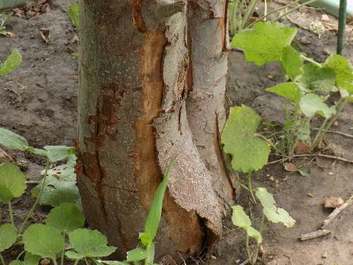Trees Losing Bark and Dying
However, this year, we are seeing a wide variety of trees losing more than just the outer layer of bark and then dying quickly. I think what is happening is all related to the November freeze last fall. In this area of Kansas, we went from 69 degrees on November 10 to 19 degrees the following morning. Unfortunately, many trees had not hardened off yet and were damaged. The first sign of damage was marcescence where trees that normally drop their leaves in the fall, didn’t. Leaves didn’t drop because they didn’t have enough time to develop an abscission layer at the base of each leaf that allowed it to fall. Though marcescence itself does not harm the tree, it is a clue that further damage may have occurred.
So, what happened? I think this is all related to damage to the living tissue under the bark. The sharp drop in temperature killed at least a portion the phloem and the cambium. Remember the phloem carries food made in the leaves to all parts of the plants including the roots. The cambium produces new phloem as well as xylem. Xylem will be discussed later. Now that the phloem is dead and the cambium cannot produce new, living phloem, the roots don’t receive the food needed to survive and eventually starve to death.
Why didn’t these trees die immediately? First of all, a healthy root system has stored energy reserves that it can use to keep the tree alive. When those reserves are depleted, the tree dies very quickly.
However, a tree also needs water. Since the living portion of the trunk was killed, wouldn’t this stop water flow? Actually, it would not. The reason it would not is due to how a tree grows and, specifically, how xylem works. Xylem is the structure that carries water from the roots to the top portions of the plant. Even in perfectly healthy trees, most of the xylem is dead. This dead xylem forms hollow tubes that carry the vast majority of water and nutrients throughout the plant. Though there are living xylem cells, the contents of those cells make them inefficient in
moving water. Therefore, the functional portion of the xylem wasn’t hurt by the freeze because it was already dead. Since this xylem system still works, the tree can live for quite a period of time until the roots starve.
Does that mean a tree with cracking or lost bark will die? It all depends on how much of the living tissue under the bark was killed. If only a small portion was killed then the tree may recover. If the entire circumference was killed, it is done for and there isn’t anything you can do to save it. Any portion of the trunk where the bark comes off and the underlying layer is brown is dead.
If you are unsure how much of the trunk was damaged, continue to water the tree as needed until the twigs become brittle. If the twigs become brittle, the tree is dead. (Ward Upham)




Leave a Reply
You must be logged in to post a comment.